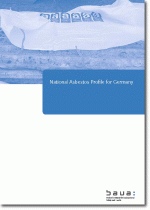From wonder mineral to hazardous legacy
Asbestos is a natural substance that, as the "mineral of a thousand possibilities", has been used in industrial and consumer-facing settings for over 100 years. Approximately 4.4 million tonnes of asbestos were imported into West and East Germany between 1950 and 1985. More than 3,500 different products were made from it, many of them for the construction of residential and other buildings. Asbestos is known to have been used in fire-resistant and thermal-insulation materials, as well as roof and facade panels. However, asbestos was also incorporated into numerous other construction products. Even today asbestos can be found in many buildings, for example in floor coverings, plasters, fillers, and tile adhesives.
Asbestos poses major health risks. Over 35 million tonnes of asbestos-containing materials are still present in German buildings today. When construction work is done in and on older buildings, it can result in the release of carcinogenic, asbestos-contaminated dust from these materials. Construction and renovation companies know how to deal with this problem, and employers have a duty to protect their employees, users, and the environment from the hazards it creates. But private property owners and tenants who want to refurbish or alter a property themselves are also required to check whether there are construction materials that possibly contain asbestos in the building. You can read here what action to take if you think you are likely to encounter asbestos during the work you are planning.
BAuA’s German-language website offers extensive guidance on planning and preparation, the safe conduct of operations, and the disposal of asbestos-containing materials when work is done on and in older buildings, along with links to other sources of information.
Asbestos as a health risk
It was mainly workers who were exposed to the health risks caused by asbestos, which had already been identified at the beginning of the twentieth century. Lung cancer in conjunction with asbestosis has been officially recognized as an occupational disease in Germany since 1942. However, it remained unclear for many years why asbestos acts as a carcinogen. In 1972 the scientists Pott and Stanton published their hypothesis that biologically resistant fibres of a certain length and thinness could have carcinogenic effects. The fibre hypothesis has gained international recognition in the intervening period, and other biopersistent fibres have also been found to cause cancerous conditions.
Asbestos banned in Germany since 1993
The authorities responded far too late to the risks linked with asbestos in the workplace. It was not until 1972 that the first protective regulations were adopted in the Federal Republic of Germany. Over the years that followed, they significantly reduced the levels of exposure to asbestos in workplaces. Yet even these precautionary measures were not enough to ensure workers’ safety. The realization that it was impossible to guarantee the "controlled handling" of asbestos products over their entire life cycle led to a complete ban on the manufacture, marketing, and use of these products in Germany in 1993. The European Union also decided to completely end the use of asbestos in 2005.
The average latency period between exposure to asbestos and the development of cancer is more than thirty years. This means the consequences of the inadequate occupational safety and health standards applied in the past are only becoming fully apparent today, for asbestos consumption was rising continuously in Germany right up to the mid-1970s. According to the National Asbestos Profile for Germany (Nationales Asbest Profil Deutschland), more than 1,600 people died of asbestos-related conditions in 2017. Between 1994 and 2017, more than 34,000 people in Germany died prematurely as a result of the mineral. In 2006, the World Health Organization and the International Labour Organization (ILO) in Geneva calculated 100,000 asbestos deaths per year worldwide. More recent estimates (2018) based on data from the World Health Organisation (Global Burden of Disease, 2016) using current evidence on the link between mesothelioma caused by asbestos and lung cancer caused by asbestos arrive at much higher figures of around 233,000 deaths per year globally.
